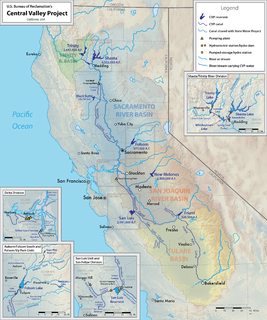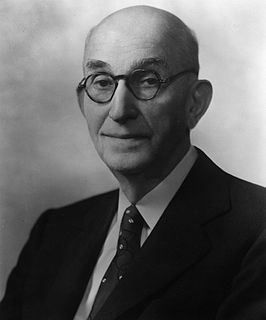
The Reclamation Act of 1902 is a United States federal law that funded irrigation projects for the arid lands of 20 states in the American West.

Grand Coulee Dam is a concrete gravity dam on the Columbia River in the U.S. state of Washington, built to produce hydroelectric power and provide irrigation water. Constructed between 1933 and 1942, Grand Coulee originally had only two powerhouses. The third powerhouse, completed in 1974 to increase energy production, makes Grand Coulee the largest power station in the United States by nameplate-capacity at 6,809 MW.

The United States Bureau of Reclamation (USBR), and formerly the United States Reclamation Service, is a federal agency under the U.S. Department of the Interior, which oversees water resource management, specifically as it applies to the oversight and operation of the diversion, delivery, and storage projects that it has built throughout the western United States for irrigation, water supply, and attendant hydroelectric power generation. Currently the USBR is the largest wholesaler of water in the country, bringing water to more than 31 million people, and providing one in five Western farmers with irrigation water for 10 million acres of farmland, which produce 60% of the nation's vegetables and 25% of its fruits and nuts. The USBR is also the second largest producer of hydroelectric power in the western United States.

The Central Valley Project (CVP) is a federal water management project in the U.S. state of California under the supervision of the United States Bureau of Reclamation (USBR). It was devised in 1933 in order to provide irrigation and municipal water to much of California's Central Valley—by regulating and storing water in reservoirs in the northern half of the state, and transporting it to the water-poor San Joaquin Valley and its surroundings by means of a series of canals, aqueducts and pump plants, some shared with the California State Water Project (SWP). Many CVP water users are represented by the Central Valley Project Water Association.

Carl Trumbull Hayden was an American politician and the first United States Senator to serve seven terms. Serving as Arizona's first Representative for eight terms before entering the Senate, Hayden set the record for longest-serving member of the United States Congress more than a decade before his retirement from politics. The longtime Dean of the United States Senate served as its president pro tempore and chairman of both its Rules and Administration and Appropriations committees. He was a member of the Democratic Party.

Mine reclamation is the process of restoring land that has been mined to a natural or economically usable state. Although the process of mine reclamation occurs once mining is completed, the planning of mine reclamation activities occurs prior to a mine being permitted or started. Mine reclamation creates useful landscapes that meet a variety of goals ranging from the restoration of productive ecosystems to the creation of industrial and municipal resources. In the United States, mine reclamation is a regular part of modern mining practices. Modern mine reclamation minimizes and mitigates the environmental effects of mining.
Reclaim, reclaiming or reclamation means "to get something back". It may refer to:

The U.S. House Committee on Natural Resources or Natural Resources Committee is a Congressional committee of the United States House of Representatives. Originally called the Committee on Interior and Insular Affairs (1951), the name was changed to the Committee on Natural Resources in 1991. The name was shortened to the Committee on Resources in 1995 by the new Chairman, Don Young. Following the Democratic takeover of the House of Representatives in 2006, the name of the committee was changed back to its title used between 1991 and 1995.

The Surface Mining Control and Reclamation Act of 1977 (SMCRA) is the primary federal law that regulates the environmental effects of coal mining in the United States.

The Office of Surface Mining Reclamation and Enforcement (OSMRE) is a branch of the United States Department of the Interior. It is the federal agency entrusted with the implementation and enforcement of the Surface Mining Control and Reclamation Act of 1977 (SMCRA), which attached a per-ton fee to all extracted coal in order to fund an interest-accruing trust to be used for reclamation of abandoned mine lands, as well as established a set environmental standards that mines must follow while operating, and achieve when reclaiming mined land, in order to minimize environmental impact. OSMRE has about 500 employees, who work in either the national office in Washington, DC, or of the many regional and field offices(OSM's Three Regions).

Wayne Norviel Aspinall was a lawyer and politician from Colorado. He is largely known for his tenure in the United States House of Representatives, serving as a Democrat from 1949–1973 from Colorado's Fourth District. Aspinall became known for his direction of the House Interior and Insular Affairs Committee, of which he was the chairman from 1959–1973. Aspinall focused the majority of his efforts on western land and water issues.

The United States Watershed Protection and Flood Prevention Act of 1954 is a United States statute. It has been amended several times.
The National Historic Preservation Act of 1966 (NHPA) envisioned a funding source to provide states with matching funds to implement the Act. The Act was to be implemented through partnerships with states, Indian Tribes, Native Hawaiians, local governments, nonprofit organizations, and the private sector. It brought forth state programs to implement much of the Act; a National Register of Historic Places encompassing a wide range of sites and structures deemed historic; partnerships at all levels of government; incentives; assistance; and reviews. The NHPA endorsed the use of federal financial support for the national preservation program and called for two basic categories of assistance, both of which provide funding, rather than technical assistance, for historic preservation projects and to individuals for the preservation of properties listed in the National Register of Historic Places. Since enactment in 1966, repeated efforts to fund the HPF was realized after a 10-year campaign when consistent funding was authorized on September 28, 1976, through Public Law 94-422. The law amended the National Historic Preservation Act to establish a funding source known as the Historic Preservation Fund for a historic preservation grant program to provide assistance to non-federal entities.
The Animas-La Plata water project is a water project designed to fulfill the water rights settlement of the Ute Mountain and the Southern Ute tribes of the Ute Nation in Colorado, USA.
The Central Utah Project Completion Act (CUPCA) enacted on October 30, 1992, removed responsibility for completing the Central Utah Project, a federal water project, from the United States Bureau of Reclamation. The Central Utah Project Completion Act then distributed responsibility for the project:

The Omnibus Public Land Management Act of 2009 is a land management law passed in the 111th United States Congress and signed into law by President Barack Obama on March 30, 2009. The bill designates millions of acres in the US as protected and establishes a National Landscape Conservation System. It includes funding for programs, studies and other activities by the Department of the Interior and the Department of Agriculture, and in some cases bars further geothermal leasing, oil and gas leasing, and new mining patents on certain stretches of protected land.
Lake Nighthorse is a reservoir created by the 270 feet (82 m) high Ridges Basin Dam Southwest of Durango in La Plata County Colorado. As part of the Animas-La Plata Water Project, Lake Nighthorse provides water storage for tribal and water right claim-holders along the Animas River.
The Energy and Water Development and Related Agencies Appropriations Act, 2014 refers to appropriations bills introduced during the 113th United States Congress. There are two different versions: H.R. 2609 in the House of Representatives and S. 1245 in the Senate. The bill was later incorporated as Division D of the Consolidated Appropriations Act, 2014, which was enacted in January 2014.

The Three Kids Mine Remediation and Reclamation Act is a U.S. public law that authorizes the sale of approximately 950 acres of federal land to the city of Henderson, Nevada. The land used to be a mine and now needs significant environmental remediation and reclamation. The bill was introduced into the United States House of Representatives during the 113th United States Congress; a previous version passed the House during the 112th United States Congress, but never received a vote in the Senate. Cleanup efforts of the land are expected to cost between $300 million and $1.2 billion, depending on various estimates and cleanup targets.

The RECLAIM Act was simultaneously introduced in the U.S. Senate and U.S. House of Representatives on March 27, 2017 by Senator Mitch McConnell (R-KY) and Representative Hal Rogers (R-KY-5). The bill authorizes the use of funds generated by Surface Mining Control and Reclamation Act of 1977 (SMCRA) to be invested in communities adversely affected by the cessation of mining operations in the area.












